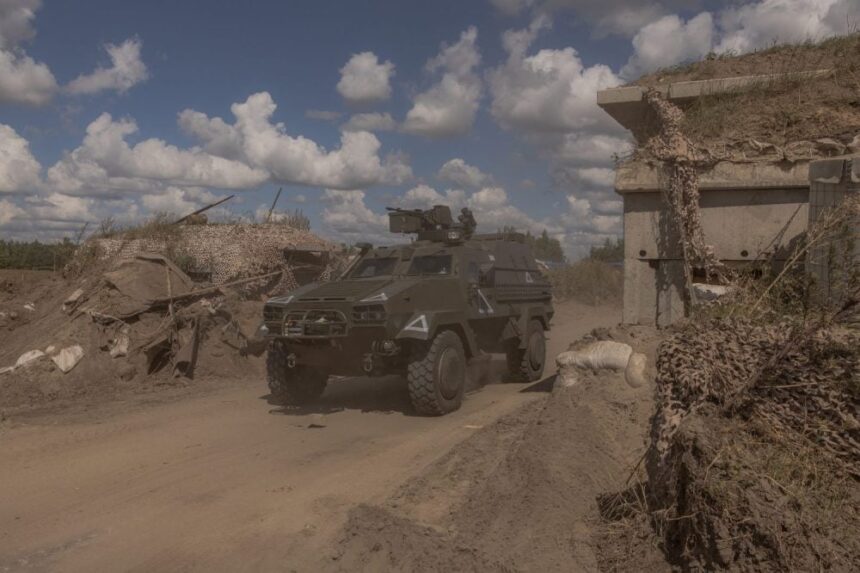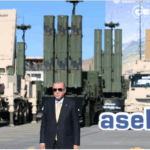The Geopolitical Opportunity of Ukraine’s Kursk Offensive
Ukrainian offensives onto Russian soil, such as the one currently underway in the Kursk region, present an opportunity to end the war more quickly as part of a wider strategy of sequencing the United States’ geopolitical challenges. Such a sequencing strategy, as I wrote in Foreign Policy on the second day of Russia’s invasion, is the best option for avoiding wars against China, Iran, and Russia simultaneously and on multiple fronts. By giving the Ukrainians the tools they need to consolidate and perhaps build on their recent gains, Washington has a chance to help Kyiv compel Moscow to the negotiating table, buy time for the West to rearm, and allow the United States to shift attention to the Indo-Pacific. But doing that will require U.S. President Joe Biden’s administration to remove restrictions on Ukraine’s use of U.S. weapons and define a clear and attainable end state for the conflict. While this is risky, it is preferable to the alternative of drip-feeding aid to Ukraine until China or Iran confronts the United States with a two-front war.
To see the opportunity the Kursk offensive creates, one has to understand how the offensive differs from other Ukrainian incursions into Russia since 2022. First, it is on a much bigger scale, involving elements of at least five brigades, including some of Ukraine’s best, Western-trained units, as well as tanks, artillery, drones, and fighter aircraft.
Second, the incursion has gone much deeper than past ones. Although the details have not been confirmed, the Ukrainians appear to control more than 70 villages on the Russian side of the border, rail lines, a key gas transit hub, and a total of more than 1,000 square kilometers (386 square miles). Third, rather than leaving after a successful raid, the Ukrainians appear to be bringing in additional forces and equipment—and digging in.
A lot could still go wrong. For one, the offensive could draw Ukrainian manpower away from other fronts where Russian forces are attacking. Although Moscow has been slow to rush new forces to Kursk, the Russians still have larger reserves to draw from.
Nevertheless, the incursion revealed surprising Russian weaknesses. Russia’s borders were barely defended. The Ukrainians achieved strategic surprise, brought the war home to their adversary, and gave Ukraine a much-needed morale boost. Now Putin faces the dilemma of downplaying the attack as a nuisance and making do with conscripts (a politically unpopular move), domestic security forces, and a few redeployed frontline troops—or trying to evict the Ukrainians and fortify the rest of the border with a much larger redeployment. So far he has chosen the former option, which means he may contain but is unlikely to eject the Ukrainian bridgehead.
In spite of their numerical inferiority, the Ukrainians have a good chance of holding their ground. So far, the war has revealed unexpected advantages of defense over offense in positional warfare. With the fall rainy season around the corner, it’s possible that the Ukrainians will be able to form a durable salient that defies easy dislodgement. Going forward, the Russians won’t be able to avoid having more troops on hand to keep an eye on the country’s long, porous borders.
These developments matter strategically because they call into question what has been for some time now the obvious Russian theory of victory, which hinges on the idea that protracting the war works to Russia’s advantage as the larger and presumably stronger party in the conflict. Even if the Kursk operation ultimately fails, it allows us to picture a Ukrainian strategy that could reverse the current apparent stalemate to Ukraine’s relative advantage. As the Prussian military theorist Carl von Clausewitz wrote in the 19th century, “The seizure of a lightly held or undefended province is an advantage in itself; and should this advantage be enough to make the enemy fear for the final outcome it can be considered a short cut on the road to peace.” If Kyiv can take and hold Russian border regions, even on a small scale, then Moscow will have to reckon with the possibility that it is vulnerable to a more consequential kind of pain on its home territory than what it has so far endured due to Western sanctions.
All of this has implications for wider U.S. strategy. I have long argued that the United States’ optimal approach to Russia’s war in Ukraine is to use it as an opportunity to inflict a proxy defeat on Russia on a faster timeline than China is prepared to move against Taiwan. The last two national defense strategies made it clear that the United States is not prepared to fight wars against more than one major opponent at the same time. By using resources in a focused and disciplined way against Russia’s ongoing aggression, the United States has a chance to weaken the Russian threat to Europe—and on that basis, freeing up bandwidth to strengthen deterrence in the Indo-Pacific.
The problem is that the United States has not used its time as well as its opponents. Since the start of the Ukraine war, the U.S. defense budget has remained relatively static, while Russia’s has tripled. China has used this time to insulate its banking industry against sanctions, reorient energy supplies to routes that the United States cannot as easily disrupt, build up assault forces near Taiwan, and accelerate efforts to achieve nuclear parity with the United States. Iran has used this time to increase its defense budget, pump military equipment to its proxies across the Middle East, and shrink its nuclear breakout time to just about zero.
While its adversaries have been arming round-the-clock, the United States has struggled to get its defense industrial base to a state that is even capable of supporting Ukraine. By the Pentagon’s estimates, the United States is on track to producing 80,000155 155-millimeter howitzer shells per month. That sounds impressive until one considers that Ukraine needs at least 75,000 a month just to sustain its defensive positions—and that in the mid-1990s, the United States was producing more than 800,000 artillery rounds a month. Russia—whose economy is the same size as the Netherlands’—is currently producing three times as much ammunition as the United States and Europe combined. According to a recent estimate, it will take five years at current production levels to replenish the inventories of Patriot missile interceptors, Javelin anti-tank systems, and Stinger air-defense systems that the United States has provided to Ukraine.
The situation is even worse in Europe. Despite much high-flying rhetoric, most NATO states have made only half-hearted efforts to prepare for war—the prerequisite for deterring one. Despite declaring a turnaround in its willingness to rearm, Germany has allowed shortfalls in its defense budget for the past two years. It recently halved Ukraine aid and funded the 2025 defense budget with a small increase that will barely make up for inflation, rather than what the German Defense Ministry requested. Promises by Western European allies at the 2022 and 2023 NATO summits to deploy division-sized units to NATO’s eastern flank and subsequent pledges to improve air defenses there have not been met. A recent report found that Europe lacks the “preparedness, industrial capacity and supply chains, magazine depth, logistics, mass, resources, and especially the ‘will to fight’” to wage a protracted conflict.
In short, Washington and its allies have not used the time since the shock of Russia’s invasion wisely, but their adversaries have. For well over two years, it has been manifestly evident what scale of effort would be required in a protracted conflict with a major, industrialized opponent. And yet neither the United States nor its allies have mounted anything close to what would be required to prepare for such an eventuality.
It is against this backdrop that Ukrainian incursions into Russia—like the one in Kursk—take on strategic significance. If the Ukrainians can hold their ground and credibly demonstrate their ability to put even small areas of Russia at risk, then they may, with time, be able to compel Russian President Vladimir Putin to the negotiating table on terms that are much more favorable to Kyiv. Ukrainian President Volodymyr Zelensky has stated explicitly that this is the aim of the operation. Putin acknowledged as much when he said that “the enemy seeks to improve its negotiating positions in the future.”
It’s worth underscoring the unique role that territory has played in the final stages of Eastern European wars. In the past, Russia has been prevented from achieving lopsided terms after a war only when its opponent held Russian territory. At the end of the Polish-Soviet War in 1921, for example, Soviet Russia ended its westward march only after Polish armies occupied portions of Soviet territory. By contrast, the Finnish-Soviet Winter War ended with the cession of large tracts of Finnish territory because the Finns were unable to occupy Soviet territory, despite winning most of the military engagements in the war.
In other words, soil is the single most important leverage that Ukraine can amass, more valuable than sanctions relief or other economic incentives to Russia. The West’s aim should therefore be to help Zelenksy hold Russian soil as a way of bringing the war to an end as quickly as possible and on the best possible terms to Ukraine.
That will require the Biden administration to do two things it has so far been unwilling to do. First, it should provide Ukraine with the weapons it needs to sustain a battlefield advantage and remove the restrictions on how Kyiv uses those weapons. This is not without risk, since Russia could respond by escalating the conflict in ways that directly threaten NATO or the United States. But these risks have to be considered against the risks of the alternatives: attempting to prioritize Asia before Europe is stable, for example, or trying something more dramatic and dangerous, such as a preemptive strike against Iran. Perhaps the worst would be to continue on the current, incremental path, which could confront Washington with a Chinese move against Taiwan at a moment when U.S. military stocks have been depleted—a scenario that would have its own arguably greater escalatory potential.
Second, Washington needs to define clear and attainable political objectives for the war. The aim should be a sovereign Ukraine in its borders prior to February 2022, in charge of its own foreign policy, economically viable, and militarily strong. That’s not just valuable intrinsically; it also has the potential to act as a breakwater against future Russian aggression in Europe, thereby assisting the U.S. goal of focusing more on Asia.
Defining U.S. objectives along these lines means jettisoning the Biden administration’s vague and vacillating approach to the war. Biden has repeatedly suggested that the end goal is regime change in Russia. In addition to not being obviously achievable, framing U.S. objectives in this way makes it difficult for the United States to support Ukraine when it reaches a point on the battlefield where negotiations become desirable. Diplomacy is not surrender or sweet reasonableness in the face of aggression; rather, as Clausewitz wrote, it is the crucial medium by which states find a “shorter route to the goal than the destruction of the opposing armies.”
On both points—more military aid without restrictions and clarity on the end goal—Washington and its allies should be animated by a sense of urgency. The clock is working against the United States: A sequencing strategy is riskier today than it was in 2022 for the simple reason that time has not been used wisely. But the risks of sequencing are still lower than the risks of the alternatives. Sequencing deserves another, potentially last shot.
That’s why a two-pronged approach—both helping the Ukrainians and moving faster to enable the defense-industrial base to support the U.S. military in a war with more than one great-power rival—is crucial. It’s also crucial that Washington push European allies to do much more than they are currently doing to prepare for war. Otherwise, all that is gained is a short reprieve that doesn’t really allow the United States to strengthen its posture in Asia in hopes of deterring war.
Strategy is not fixed but situational. Americans and their allies need to wake up to realities and looming choices. Unless the United States starts to seriously prepare for war, it may find itself actually having to fight one—or worse, several at the same time.
By A. Wess Mitchell
Source: Foreign Policy







